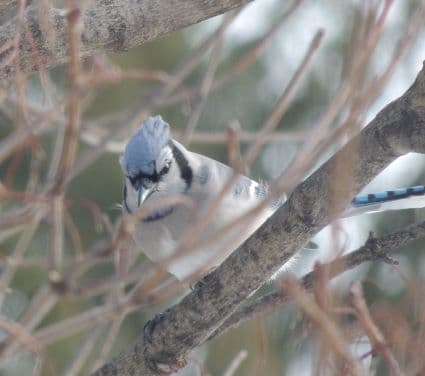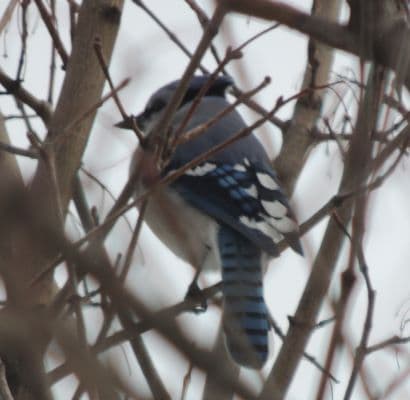Blue Jay Birds

About the Blue Jay Bird
Blue Jays are a popular and common songbird at home backyard bird feeders. They are easily identifiable. Bird watchers love this attractive bird that sports a bright, light blue color. They are also frequent, but unwanted visitors to home gardens of gardeners who grow corn and sunflowers. The Blue jay is considered a smart, and intelligent bird. They are quite aggressive. You can watch them intimidate and scare other smaller birds away from your feeders.
Have your camera ready on a nearby table. You will want to capture them at your bird feeder or on top of a sunflower munching on the seeds.
Blue Jay Trivia: Odd as it may seem, Blue Jays are not blue. They refract light in such a way as to make them appear blue.
Blue Jay Identification
When it comes to backyard birds, blue jays are on the larger size. Their size is between that of a robin and a crow. They have a length of 9-12″, and a wingspan up to 17″.
Identifying Blue Jays is simple. They are a bright, light blue, with a white underbelly. There is a U-shaped black ring on their necks. The feathers on the wings are blue with some white tips and black stripes. The tail feathers have black stripes. Their short, stout, cone-shaped beak is perfect for cracking seed shells and nuts. Their feet are designed for perching in trees.
Even when you can’t see them, you can hear their loud, noisy call. It’s certain to scare smaller birds away from your feeder.
There are four major varieties:
Northern Blue Jay, in the Northeast U.S. and Canada.
Coastal Blue Jays can be found from North Carolina to Texas.
Interior Blue Jay is found in the middle parts of the country.
Florida Blue Jay makes its home in southern Florida.
Habitat
Blue Jays are found in many parts of the country east of the Mississippi River. Most of these birds are year-round residents, although a few will migrate south for the winter.
They are common visitors to backyard bird feeders. Upon arriving at your feeder, they quickly chase away other songbirds. It helps to attract them, with a few trees and bushes. Their favorite habitat is open woodlands and the edge of forests. They like most trees, except for coniferous trees. Also, they are well adapted to cities and urban environments with trees and wooded parks.
Got an oak tree? Then, you are bound to have a pair or two visiting your yard, to snack on the acorns when in season.
Lifespan:
In the wild, the average lifespan of blue jays is 7 years. But they have been known to live up to 17 years.
Falcons, hawks, and owls are common predators. Occasionally, snakes, raccoons, and a few other animals will prey on them, too.
State Birds: Surprisingly, Blue Jays are not listed as the official state bird for ANY of the U.S. states!

Blue Jay Diet
Blue Jays absolutely love acorns and peanuts. Suet feeders with peanuts is a good way to attract them. They are very fond of sunflower seeds and many other seeds. They are opportunistic birds, and will on occasion eat bugs, snails, bird eggs, young hatchlings, and a variety of other foods.
Reproduction and Nesting:
The birds normally mate for life. After a mating ritual, the female selects a male to mate with. After mating both males and females build the nest together. The female lays 4-6 bluish-green eggs with brown spots. The female sits on the nest during the entire 17-18 day incubation period. While she is on the nest, the male feeds her. After the eggs have hatched, both male and female birds tend to the hatchlings. The young birds leave the nest after about 3 weeks. The parents will continue to feed the young birds for another month or two.
More on Birds
Find more information on how to attract your favorite birds to your back yard, and how to keep them there:
Learn About Other Birds
Please support our site. Shop for:

- rmmatthews100@hotmail.com
- 585-721-6528
- Rochester, NY
©1999-2024 GardenersNet.Com, All Rights Reserved

